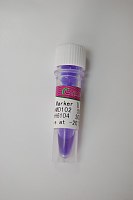In mammalian cells, the rate of DNA synthesis decreases after X-ray exposure. The dose-response curve indicates a biphasic kinetics of inhibition (
see Fig. 1 ). The initial, steep component of the curve represents inhibition of initiation of new replicons, whereas the shallow component is a manifestation of chain growth failure. The latter is probably owing to direct interference by DNA lesions with the replication machinery; on the other hand, slowdown of replicon initiation is one of the manifestations of an active signal-mediated response. Evidence for this was obtained from studies on cells derived from patients with the autosomal-recessive human diseases ataxia telangiectasia (AT) and Nijmegen Breakage Syndrome (NBS), and on some laboratory-generated radiosensitive rodent cell lines (
1 ,
2 ). AT and NBS cells have virtually lost the steep component of the inhibition curve. This property is usually referred to as “radioresistant DNA synthesis” (RDS), a phrase originally coined by Painter (
3 ). In the rodent mutants, diminished replicon initiation is also evident, but the degree of DNA synthesis inhibition is generally lower in the parental hamster cell lines as well (
4 ,
5 ).
Fig. 1. Inhibition of DNA replication by ionizing radiation in primary human fibroblasts. Left, dose-response curve measured in the first 3 h after exposure. Right, timecourse after exposure to 20 Gy of γ-rays. (Measured with 30-min labeling pulses).






